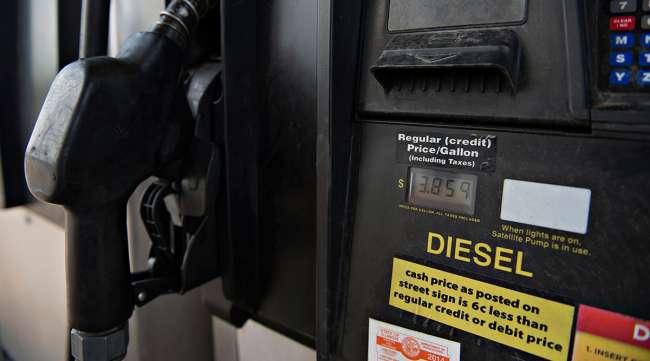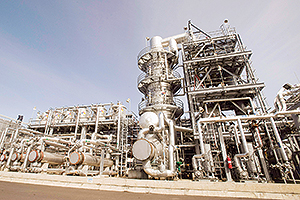Senior Reporter
Diesel Drops 7.3¢ to $2.586 a Gallon in 12th Straight Decline

[Stay on top of transportation news: Get TTNews in your inbox.]
The U.S. average retail price of diesel fell 7.3 cents to $2.586 per gallon, the Department of Energy reported March 30. Oil fell by 15% as excess global production continued even as demand plunged with the spread of the coronavirus.
Diesel declined for the 12th consecutive week.
Trucking’s main fuel costs 49.2 cents less than it did a year ago, according to DOE.
Prices fell across all regions. The lowest was in the Gulf Coast, where diesel dropped 7.5 cents to $2.363 per gallon. The highest was $3.395 in California, although that was 15.7 cents lower than the week before.
U.S. average on-highway #diesel fuel price on 3/30/2020 was $2.586/gal, DOWN 7.3¢/gallon from 3/23/2020, DOWN 49.2¢/gallon from year ago https://t.co/dzmoAJEJsE #truckers #shippers #fuelprices pic.twitter.com/xj8LtYBmNf — EIA (@EIAgov) March 31, 2020
The U.S. average price of a gallon of gasoline fell 11.5 cents to $2.005 per gallon, according to DOE’s Energy Information Administration. It was 68.6 cents less than a year earlier. Average gasoline prices fell in all regions.
“As the COVID-19 outbreak continues, gross refinery inputs and petroleum product demand remain highly uncertain,” EIA reported.
U.S. average price for regular-grade #gasoline on 3/30/2020 was $2.005/gal, DOWN 11.5¢/gallon from 3/23/2020, DOWN 68.6¢/gallon from year ago https://t.co/O2Kmjpvdr6 #gasprices pic.twitter.com/3GrYFD0vYn — EIA (@EIAgov) March 31, 2020
In related news, Oregon Gov. Kate Brown in March signed an executive order that doubles the carbon reduction requirement for all transportation fuels sold in the state to achieve a 20% greenhouse gas reduction by 2030 and a 25% reduction by 2035 compared with 2015 levels.
The Oregon Department of Environmental Quality, which manages the state’s Clean Fuels Program, estimated renewable diesel use is expected to show substantial expansion in Oregon, soaring to an expected 26.7 million gallons in 2020 compared with 1.2 million gallons consumed in 2018. Biodiesel use in the state is expected to grow to 52.6 million gallons in 2020 compared with 51.7 million gallons of usage in 2018.
Oregon is home to more than 150,000 diesel-powered commercial vehicles and just a few hundred natural gas-powered vehicles, according to research commissioned by the Diesel Technology Forum.

Schaeffer
“One of the benefits of the Clean Fuels Program is that it sets a performance goal in the form of carbon reduction and lets the marketplace determine the most effective approach to achieve these goals,” said Allen Schaeffer, executive director of the Diesel Technology Forum. The not-for-profit educational organization represents manufacturers of diesel engines and vehicles, key suppliers and fuel producers.
“Biodiesel and renewable diesel fuel may use existing fuel infrastructure while any diesel vehicle or equipment may operate using these high-quality advanced biofuels. Unlike other alternatives, there is no need to invest in expensive refueling or recharging infrastructure, or purchase new engines and equipment to realize these benefits,” he said.

A biodiesel plant in Seattle. The National Biodiesel Board says 2.8 billion gallons of biodiesel and renewable hydrocarbon diesel were sold in 2019 compared with 545 million gallons a decade earlier. (Carlos Javier Sanchez/Bloomberg News)
The National Biodiesel Board reported 2.8 billion gallons of biodiesel and renewable hydrocarbon diesel were sold in 2019 compared with 545 million gallons in 2009. More than 100 biodiesel plants produce low-carbon transportation fuels, with capacities ranging from less than 2 million gallons a year to more than 100 million gallons.
West Texas Intermediate crude futures on the New York Mercantile Exchange closed at $20.36 on March 30 compared with $23.36 per barrel March 23.
A huge oversupply is further collapsing the oil market’s structure, and more weakness may be coming as the world quickly runs out of storage capacity, Bloomberg News reported. The slump in demand has shut refineries from South Africa to Canada, leading to excess barrels in the market.
Meanwhile, President Donald Trump said March 30 that he does not want to see the energy sector “wiped out” over low oil prices brought on by the dispute between Russia and Saudi Arabia over production levels.
WTI futures rose to $26.37 on April 1 after Trump said Russia and Saudi Arabia would announce crude production cuts.
At the same time, still swelling stockpiles are weighing down the market. At the key storage hub of Cushing, Okla., inventories are said to have ballooned, raising fears about storage capacity limits being reached, according to Bloomberg.
For the week ending March 27, U.S. commercial crude oil inventories, excluding those in the Strategic Petroleum Reserve, increased by 13.8 million barrels from the previous week. At 469.2 million barrels, these inventories are near the five-year average for this time of year.
Total motor gasoline inventories increased by 7.5 million barrels in the period and are about 4% above the five-year average for this time of year. Inventories of distillate fuel — primarily ultra-low-sulfur diesel used in transportation and, to a lesser degree, as heating oil — decreased by 2.2 million barrels and are about 13% below the five-year average for this time of year, EIA reported.
Want more news? Listen to today's daily briefing:




